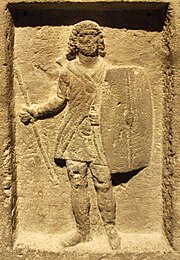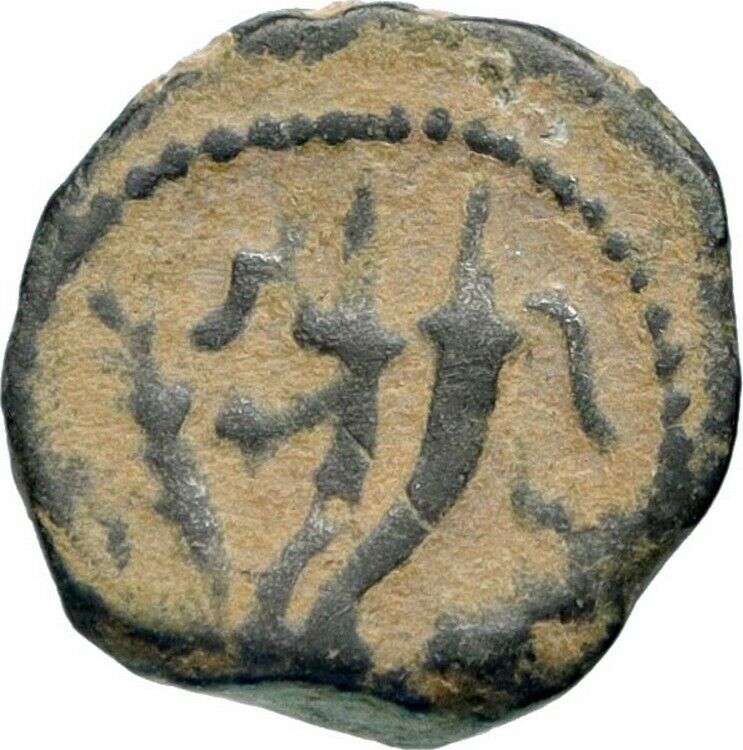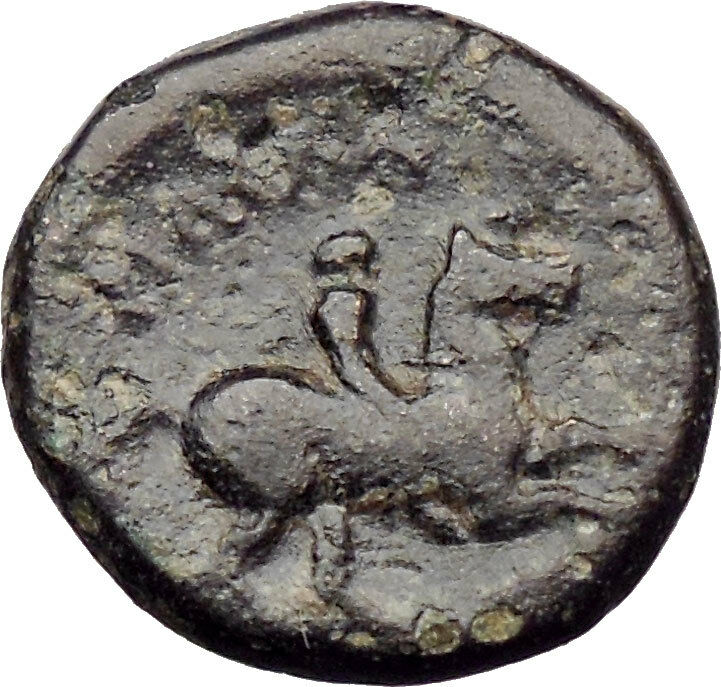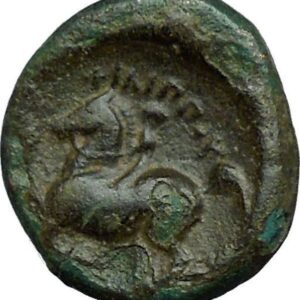|
Greek coin of the Kingdom of Bosporus
Leukon II – Spartocid Dynasty King, circa 240-220 B.C.
Bronze 24mm (12.40 grams) Pantikapaion mint
Reference: HGC 7, 189 Rare R1; MacDonald 99; Anohin 134
Head of young Hercules right, wearing lion skin headdress.
ΒΑΣΙΛΕΩΣ / ΛΕΥΚΩΝOΣ above and below the club and bow of Hercules.
You are bidding on the exact item pictured, provided with a Certificate of Authenticity and Lifetime Guarantee of Authenticity.
Hercules is the Roman name for the Greek divine hero Heracles, who was the son of Zeus (Roman equivalent Jupiter) and the mortal Alcmene. In classical mythology, Hercules is famous for his strength and for his numerous far-ranging adventures.
 The Romans adapted the Greek hero’s iconography and myths for their literature and art under the name Hercules. In later Western art and literature and in popular culture, Hercules is more commonly used than Heracles as the name of the hero. Hercules was a multifaceted figure with contradictory characteristics, which enabled later artists and writers to pick and choose how to represent him. This article provides an introduction to representations of Hercules in the later tradition. The Romans adapted the Greek hero’s iconography and myths for their literature and art under the name Hercules. In later Western art and literature and in popular culture, Hercules is more commonly used than Heracles as the name of the hero. Hercules was a multifaceted figure with contradictory characteristics, which enabled later artists and writers to pick and choose how to represent him. This article provides an introduction to representations of Hercules in the later tradition.
Labors of Hercules
Hercules is known for his many adventures, which took him to the far reaches of the Greco-Roman world. One cycle of these adventures became canonical as the “Twelve Labours,” but the list has variations. One traditional order of the labours is found in the Bibliotheca as follows:
- Slay the Nemean Lion.
- Slay the nine-headed Lernaean Hydra.
- Capture the Golden Hind of Artemis.
- Capture the Erymanthian Boar.
- Clean the Augean stables in a single day.
- Slay the Stymphalian Birds.
- Capture the Cretan Bull.
- Steal the Mares of Diomedes.
- Obtain the girdle of Hippolyta, Queen of the Amazons.
- Obtain the cattle of the monster Geryon.
- Steal the apples of the Hesperides.
- Capture and bring back Cerberus.
The Latin name Hercules was borrowed through Etruscan, where it is represented variously as Heracle, Hercle, and other forms. Hercules was a favorite subject for Etruscan art, and appears often on bronze mirrors. The Etruscan form Herceler derives from the Greek Heracles via syncope. A mild oath invoking Hercules (Hercule! or Mehercle!) was a common interjection in Classical Latin.

Baby Hercules strangling a snake sent to
kill him in his cradle (Roman marble, 2nd century CE)
Hercules had a number of myths that were distinctly Roman. One of these is Hercules’ defeat of Cacus, who was terrorizing the countryside of Rome. The hero was associated with the Aventine Hill through his son Aventinus. Mark Antony considered him a personal patron god, as did the emperor Commodus. Hercules received various forms of religious veneration, including as a deity concerned with children and childbirth, in part because of myths about his precocious infancy, and in part because he fathered countless children. Roman brides wore a special belt tied with the “knot of Hercules“, which was supposed to be hard to untie. The comic playwright Plautus presents the myth of Hercules’ conception as a sex comedy in his play Amphitryon; Seneca wrote the tragedy Hercules Furens about his bout with madness. During the Roman Imperial era, Hercules was worshipped locally from Hispania through Gaul.
Medieval mythography
After the Roman Empire became Christianized, mythological narratives were often reinterpreted as allegory, influenced by the philosophy of late antiquity. In the 4th century, Servius had described Hercules’ return from the underworld as representing his ability to overcome earthly desires and vices, or the earth itself as a consumer of bodies. In medieval mythography, Hercules was one of the heroes seen as a strong role model who demonstrated both valor and wisdom, with the monsters he battles as moral obstacles. One glossator noted that when Hercules became a constellation, he showed that strength was necessary to gain entrance to Heaven.
Medieval mythography was written almost entirely in Latin, and original Greek texts were little used as sources for Hercules’ myths.
Renaissance mythography
The Renaissance and the invention of the printing press brought a renewed interest in and publication of Greek literature. Renaissance mythography drew more extensively on the Greek tradition of Heracles, typically under the Romanized name Hercules, or the alternate name Alcides. In a chapter of his book Mythologiae (1567), the influential mythographer Natale Conti collected and summarized an extensive range of myths concerning the birth, adventures, and death of the hero under his Roman name Hercules. Conti begins his lengthy chapter on Hercules with an overview description that continues the moralizing impulse of the Middle Ages:
Hercules, who subdued and destroyed monsters, bandits, and criminals, was justly famous and renowned for his great courage. His great and glorious reputation was worldwide, and so firmly entrenched that he’ll always be remembered. In fact the ancients honored him with his own temples, altars, ceremonies, and priests. But it was his wisdom and great soul that earned those honors; noble blood, physical strength, and political power just aren’t good enough.
Panticapaeum (Greek: Παντικάπαιον, Pantikápaion), present-day Kerch: an important Greek city and port in Taurica (Tauric Chersonese), situated on a hill (Mt. Mithridates) on the western side of the Cimmerian Bosporus, founded by Milesians in the late 7th–early 6th century BC.
In the 5th–4th centuries BC, the city became the residence first of the Archaeanactids and then of the Spartocids, dynasties of Greek kings of Bosporus, and was hence itself sometimes called Bosporus. Its economic decline in the 4th–3rd centuries BC was the result of the Sarmatian conquest of the steppes and the growing competition of Egyptian grain. The last of the Spartocids, Paerisades V, apparently left his realm to Mithridates VI Eupator, king of Pontus.
This transition was arranged by one of Mithridates’s generals, a certain Diophantus, who earlier was sent to Taurica to help local Greek cities against Palacus of Lesser Scythia. The takeover didn’t go smoothly: Paerisades was murdered by Scythians led by Saumacus, Diophantus escaped to return later with reinforcements and to suppress the revolt (c. 110 BC).
Half of a century later, Mithridates himself took his life in Panticapaeum, when, after his defeat in a war against Rome, his own son and heir Pharnaces and citizens of Panticapaeum turned against him. In 63 BC the city was partly destroyed by an earthquake. Raids by the Gothss and the Huns furthered its decline, and it was incorporated into the Byzantine state under Justin I in the early 6th century AD.

Ruins of Panticapaeum in Kerch (Ukraine)
During the first centuries of the city’s existence, imported Greek articles predominated: potteryKerch Style), terracottas, and metal objects, probably from workshops in Rhodes, Corinth, Samos, and Athens. Local production, imitated from the models, was carried on at the same time. Athens manufactured a special type of bowl for the city, known as Kerch ware. Local potters imitated the Hellenistic bowls known as the Gnathia style as well as relief wares—Megarian bowls. The city minted silver coins from the mid 6th century BC and from the 1st century BC gold and bronze coins. The Hermitage and Kerch Museums contain material from the site, which is still being excavated.
Bibliography
- Noonan, Thomas S. “The Origins of the Greek Colony at Panticapaeum”, American Journal of Archaeology, Vol. 77, No. 1. (1973), pp. 77–81.
The Bosporan Kingdom, also known as the Kingdom of the Cimmerian Bosporus (Greek: Βασίλειον του Κιμμερικού Βοσπόρου Basileion tou Kimmerikou Bosporou), was an ancient state located in eastern Crimea and the Taman Peninsula on the shores of the Cimmerian Bosporus, the present-day Strait of Kerch. (It was not named after the more famous Bosphorus beside Istanbul at the other end of the Black Sea.) The Bosporan Kingdom was the longest surviving Roman client kingdom. It was a Roman province from 63 to 68 AD, under Emperor Nero. The 1st and 2nd centuries BC saw a period of renewed golden age of the Bosporan state. At the end of the 2nd century, King Sauromates II inflicted a critical defeat on the Scythians and included all the territories of the Crimea in the structure of his state.
The prosperity of the Bosporan Kingdom was based on the export of wheat, fish and slaves. The profit of the trade supported a class whose conspicuous wealth is still visible from newly discovered archaeological finds, excavated, often illegally, from numerous burial barrows known as kurgans. The once-thriving cities of the Bosporus left extensive architectural and sculptural remains, while the kurgans continue to yield spectacular Greco-Sarmatian objects, the best examples of which are now preserved in the Hermitage in St. Petersburg. These include gold work, vases imported from Athens, coarse terracottas, textile fragments and specimens of carpentry and marquetry.
Early Greek colonies
Pantikapeon and other ancient Greek colonies along the north coast of the Black Sea, along with their modern names
The whole area was dotted with Greek cities: in the west, Panticapaeum (Kerch)—the most significant city in the region, Nymphaeum and Myrmekion; on the east Phanagoria (the second city of the region), Kepoi, Germonassa, Portus Sindicus and Gorgippia.
These Greek colonies were originally settled by Milesians in the 7th and 6th centuries BC. Phanagoria (c. 540 BC) was a colony of Teos, and the foundation of Nymphaeum may have had a connection with Athens; at least it appears to have been a member of the Delian League in the 5th century.
Geography of the Bosporan Kingdom
See also: Roman Crimea
The Bosporan Kingdom was centred around the Kerch Strait between the Black Sea and the Sea of Azov, known in antiquity as the Cimmerian Bosporus from where the kingdom’s name derived.
Kings of Cimmerian Bosporan
- See Also: List of kings of Cimmerian Bosporus
Archaeanactidae dynasty
According to Greek historian Diodorus Siculus (xii. 31) the region was governed between 480 and 438 BC by a line of kings called the Archaeanactidae, probably a ruling family, usurped by a tyrant called Spartocus (438 – 431 BC), who was a Thracian.
Spartocid dynasty
Spartocus founded a dynasty which seems to have endured until c. 110 BC, known as the Spartocids. The Spartocids left many inscriptions, indicating that the earliest members of the house ruled under the titles of archons of the Greek cities and kings of various minor native tribes, notably the Sindi (from central Crimea) and other branches of the Maeotae. Surviving material (texts, inscriptions and coins) do not supply enough information to reconstruct a complete chronology of kings of the region.
Bosporan Phiale (top view), 4th century BC
Satyrus (431 – 387 BC), successor to Spartocus, established his rule over the whole region, adding Nymphaeum to his kingdom and besieging Theodosia, which was wealthy because, unlike other cities in the region, it had a port which was free of ice throughout the year, allowing it to trade grain with the rest of the Greek world, even in winter. Satyrus’ son Leucon (387 – 347 BC) would eventually take the city. He was succeeded jointly by his two sons, Spartocus II, and Paerisades; Spartocus died in 342, allowing Paerisades to reign alone until 310. After Paerisades’ death, a civil war between his sons Satyrus and Eumelus was fought. Satyrus defeated his younger brother Eumelus at the Battle of the River Thatis in 310 BC but was then killed in battle, giving Eumelus the throne.[3]
Eumelus’ successor was Spartocus III (303 – 283 BC) and after him Paerisades II. Succeeding princes repeated the family names, so it is impossible to assign them a definite order. The last of them, however, Paerisades V, unable to make headway against increasingly violent attacks from nomadic tribes in the area, called in the help of Diophantus, general of King Mithridates VI of Pontus, leaving him his kingdom. Paerisades was killed by a Scythian named Saumacus who led a rebellion against him.
The house of Spartocus was well known as a line of enlightened and wise princes; although Greek opinion could not deny that they were, strictly speaking, tyrants, they are always described as dynasts. They maintained close relations with Athens, their best customer for the Bosporan grain exports: Leucon I of Bosporus created privileges for Athenian ships at Bosporan ports. The Attic orators make numerous references to this. In return the Athenians granted Leucon Athenian citizenship and made decrees in honour of him and his sons.
Mithridates VI
The northern Black sea shores of the Pontic Kingdom (actual Crimea and Kerch peninsula) shown as part of the empire of Mithridates VI of Pontus.
After his defeat by Roman General Pompey in 63 BC, King Mithridates VI of Pontus fled with a small army from Colchis (modern Georgia) over the Caucasus Mountains to Crimea and made plans to raise yet another army to take on the Romans. His eldest living son, Machares, regent of Cimmerian Bosporus, was unwilling to aid his father, so Mithridates had Machares killed, acquiring the throne for himself. Mithridates then ordered the conscriptions and preparations for war. In 63 BC, Pharnaces, the youngest son of Mithridates, led a rebellion against his father, joined by Roman exiles in the core of Mithridates’s Pontic army. Mithridates VI withdrew to the citadel in Panticapaeum, where he committed suicide. Pompey buried Mithridates VI in a rock-cut tomb in either Sinope or Amasia,[4] the capital of the Kingdom of Pontus.
Roman client kingdom
The stele of Staphhilos from the Panticapaeum, depicting a soldier with the traditional Bosporan long hair and beard.
After the death of Mithridates VI (63 BC), Pharnaces II (63 – 47 BC) supplicated to Pompey, and then tried to regain his dominion during Julius Caesar’s Civil War, but was defeated by Caesar at Zela and was later killed by his former governor and son-in-law Asander.
Before the death of Pharnaces II, Asander had married Pharnaces II’s daughter Dynamis. Asander and Dynamis were the ruling monarchs until Caesar commanded a paternal uncle of Dynamis, Mithridates II to declare war on the Bosporan Kingdom and claimed the kingship for himself. Asander and Dynamis were defeated by Caesar’s ally and went into political exile. However, after Caesar’s death in 44 BC, the Bosporan Kingdom was restored to Asander and Dynamis by Caesar’s great nephew and heir Octavian. Asander ruled as an archon and later as king until his death in 17 BC. After the death of Asander, Dynamis was compelled to marry a Roman usurper called Scribonius, but the Romans under Agrippa intervened and established Polemon I of Pontus (16 – 8 BC) in his place. Polemon married Dynamis in 16 BC and she died in 14 BC. Polemon ruled as king until his death in 8 BC. After the death of Polemon, Aspurgus, the son of Dynamis and Asander, succeeded Polemon.
The Bosporan Kingdom of Aspurgus was a client state of the Roman Empire, protected by Roman garrisons. Aspurgus (8 BC – 38 AD) founded a dynasty of kings which endured with a couple of interruptions until 341 AD. Aspurgus adopted the Imperial Roman names “Tiberius Julius” when he received Roman citizenship and enjoyed the patronage of the first two Roman Emperors, Augustus and Tiberius. All of the following kings adopted these two Roman names followed by a third name, of Thracian (Kotys, Rhescuporis or Rhoemetalces) or local origin (such as Sauromates, Eupator, Ininthimeus, Pharsanzes, Synges, Terianes, Theothorses or Rhadamsades).
Ruins of Panticapaeum, modern Kerch, the capital of the Bosporan Kingdom.
The Roman client kings of the dynasty had descended from King Mithridates VI of Pontus and his first wife, his sister Laodice, through Aspurgus. The kings adopted a new calendar (the “Pontic Era”) introduced by Mithridates VI, starting with 297 BC to date their coins. Bosporan kings struck coinage throughout its period as a client state, which included gold staters bearing portraits of both the Roman emperor and Bosporan king. Like the Roman, Bosporan coinage became increasingly debased during the 3rd century. The coinage makes their lineages fairly clear to historians, though scarcely any events from their reigns are recorded.
The Bosporan Kingdom covered the eastern half of Crimea and the Taman peninsula, and extended along the east coast of the Maeotian marshes to Tanais at the mouth of the Don in the north-east, a great market for trade with the interior. Throughout the period there was perpetual war with the native tribes of Scythians and Sarmatians, and in this the Bosporan Kingdom was supported by its Roman suzerains, who lent the assistance of garrisons and fleets.
In 62 AD for reasons unknown, Roman emperor Nero deposed the Bosporan king Cotys I. It is possible that Nero wanted to minimise the power of local client rulers and wanted the Bosporans to be subsumed into the Roman empire. The Bosporan Kingdom was incorporated as part of the Roman province of Moesia Inferior from 63 to 68. In 68, the new Roman emperor Galba restored the Bosporan Kingdom to Rhescuporis I, the son of Cotys I.
The balance of power amongst local tribes was severely disturbed by westward migration in the 3rd–4th centuries. In the 250s AD, the Goths and Borani were able to seize Bosporan shipping and even raid the shores of Anatolia.[6]
With the coins of the last king Rhescuporis VI in 341, constructing a chronology becomes very difficult. The kingdom was probably finally overrun by the Huns, who defeated the nearby Alans in 375/376 and moved rapidly westwards towards the Roman empire.
Byzantine period
A few centuries after the Hunnic invasion, the Bosporan cities enjoyed a revival, under Byzantine and Bulgarian protection. The ancient Greek city of Phanagoria became the capital of Old Great Bulgaria between 632 and 665. From time to time Byzantine officers built fortresses and exercised authority at Bosporus, which constituted an archbishopric.
A relevant Byzantine usage of the term is found in a newly discovered seal of a general of the early 11th century as of “Πο<σ>φορ(ου)”, i.e., of the Cimmerian Bosporos.
They also held Tamatarcha on the eastern side of the strait, a town which in the 10th and 11th centuries became the seat of the Kievan Rus principality of Tmutarakan, which in turn gave way to Tatar domination.
Following the Diaspora, and aided by the Khazars, Judaism emerged in the region, and Jewish communities developed in some of the cities of the region (especially Tanais). The Jewish or Thracian influence on the region may have inspired the foundation of a cult to the “Most High God,” a distinct regional cult which emerged in the 1st century AD, which professed monotheism without being distinctively Jewish or Christian.
Coinage
Although considered rare among collectors prior to the demise of the Soviet Union in the early 1990s, Bosporan coins are now well known on the international coin markets, hinting at the quantities produced. Several large series were produced by Bosporan cities from the 5th century BC, particularly in Panticapaeum. Gold staters of Panticapaeum bearing Pan‘s head and a griffin are especially remarkable for their weight and fine workmanship.
There are coins with the names of the later Spartocids and a complete series of dated solidi issued by the later or Achaemenian dynasty. In them may be noticed the swift degeneration of the gold solidus through silver and potin to bronze.
See also
- Cimmerians
- Cimmerian Bosporus
- Kingdom of Pontus
- Roman Crimea
|





 The Romans adapted the Greek hero’s iconography and myths for their literature and art under the name Hercules. In later Western art and literature and in popular culture, Hercules is more commonly used than Heracles as the name of the hero. Hercules was a multifaceted figure with contradictory characteristics, which enabled later artists and writers to pick and choose how to represent him. This article provides an introduction to representations of Hercules in the later tradition.
The Romans adapted the Greek hero’s iconography and myths for their literature and art under the name Hercules. In later Western art and literature and in popular culture, Hercules is more commonly used than Heracles as the name of the hero. Hercules was a multifaceted figure with contradictory characteristics, which enabled later artists and writers to pick and choose how to represent him. This article provides an introduction to representations of Hercules in the later tradition.

.svg/220px-Greek_colonies_of_the_Northern_Euxine_Sea_(Black_Sea).svg.png)









